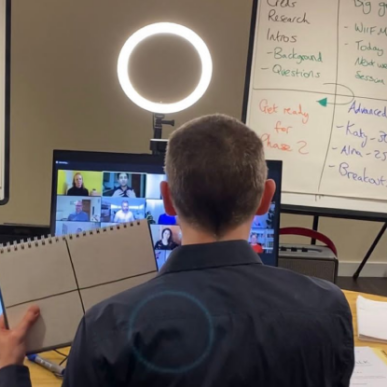8 Techniques to Highly Effective Business Storytelling
If you want to improve your business communication, whether that’s a presentation or conversation, a virtual call or an email, it’s essential that you bring in elements of storytelling to help captivate and excite your audience.
In this blog, we’ll look at eight techniques that you can use to make your business storytelling effective and engaging.
But before we even start to think about the business world imagine this:
You’re putting a child to bed. If you ask a child if they would like you to read a spreadsheet to them before bed, odds are they’re going to say no. They would rather go straight to bed than listen to that!
But if you ask “Would you like me to read you a story?” well, they’ll be ready for it, any time of the day or night.
We all love the journey of a story. We remember them. We know exactly what the flow needs to be, what the important steps in the story are.
Even my four-year-old son will correct me if I’m making up a story and I haven’t hit the right elements that every story needs to have. He’ll say, “Oh, daddy, you didn’t make it hard enough for the dragon today. Don’t you remember that he’s supposed to do this and that before he can get to the end?”
He’ll tell me it was too easy. “You need to do the story again.”
We know these critical story elements from a very young age, which means we need to make sure that whenever we’re sharing information and ideas that we’re still using a storytelling format. It’s how the human brain engages and memorizes best.
So let’s take a look at the best practices to follow when you want to transform business content into a business story.
1. Remember: You’re engaging a HUMAN, not doing a data transfer
Business presentations often fail because they become dispassionate lists of data: statistics, results, graphs, charts, you get the idea. Even though this information might be important, it’s difficult to stay engaged with data because it’s often dry and dull.
Human beings aren’t robots: we’re not built to simply receive data input and understand it. Instead, what the human brain needs is a story which taps into our emotions.
Think about how you describe your day to your partner or family. Chances are you’ll use emotive words like ‘exciting,’ ‘frustrating,’ ‘stressful’, ‘boring’ or ‘brilliant’. To make your business storytelling more engaging for people, think about emotive words that you can use to describe the information you’re sharing. Essentially, good business storytelling tells people how to feel about information.
2. Explain the big picture before the detail
When planning your business storytelling, you should always explain the big picture first before getting to the details. Give some background and context and, crucially, explain what your information is going to give your audience or the goal you can achieve.
Basically, you’re priming your audience’s brain to answer the question: “Why on earth should I read this?”
To get started with your business story you can ask yourself a couple questions:
- What is the background story behind this information?
- What’s the bigger context?
- How is this process going to benefit the reader or listener?
- What is the journey it’s going to help them on?
- How will it help their life?
Once you’ve outlined the big picture, your audience will be prepared to listen to the facts, detail and data: the process of how you’re going to get to the goal you’ve outlined. Remember to back this up with evidence wherever you can, e.g. “We know this will work, as our team in Paris has had great success with it in Q1.”
This will help you to create a journey through the information, or, in other words, a story.
3. Provide an action step at the end
Once you’ve told your story, you can’t just default to a fairy tale ending of “And they all lived happily ever after.” Nor can you say, “That’s it, any questions?”
If you do, you’ll lose all of the momentum you’ve built up. Your audience needs to know what the next chapter of the story will be.
In order to keep the momentum going, you must give people an action at the end. What is the first step that they will need to take to act upon the information that you’ve shared?
Try to avoid vague actions such as ‘go away and think about it’ – the chances are, what you’ve shared will be forgotten about almost immediately. Be clear in your instructions, for example: ‘On your next three customer calls, I want you to use this new technique at least once,” or “We’ll be having a follow up meeting in a week’s time, so I’d like you to email your feedback on this to me by close of play on Thursday so that we can discuss together.”
The clearer your instructions, the more likely people are to take action on them.
4. Craft a compelling headline
One of the biggest keys to getting people to engage with your story is to make sure the headline grabs them in the first place.
If you gather process data, case studies, spreadsheets, and information to give to people, but you title the email “systems update 9.07,” no one is going to read it.
Your headline has to be the immediate reason they should read your document. It should generally be either a statement of action — this is what you’ll need to do when you finish reading this email — or how they will benefit from the information.
Once you’ve got the headline, then you can go through your email or document and just strip out anything that doesn’t help what you’ve set up.
5. Use personal examples
All great stories feature characters. It’s characters who engage us as human beings. When characters are used to tell stories, we pay attention.
You can bring your business storytelling to life by using personal examples which relate to your information. It could be one of your own personal stories, or perhaps a case study. Maybe you can describe how your information will affect a typical client or customer.
Using personal examples like this will not only make your information more compelling to listen to, it will be much easier for your audience to understand, visualise and remember.
6. Don’t forget the pictures!
Just as pictures are an important part of a child’s storybook, so too are images in your business presentations.
Try to avoid ‘death by Powerpoint’ by cramming your slides full of text, bullet points and superfluous information. Instead, try to use strong, visual images to represent your point. These are much more captivating for your audience, as there’s less of a requirement to read through the slide to understand the point. They can simply glance, then listen.
Strong images will help make your presentation more memorable, so strip back any text and find the best pictures possible to enhance your message.
7. Practice using your voice for great delivery
When you’re telling a child a story, they’ll plead with you to ‘do the voices’. A business presentation is not all that different.
What tends to happen in business is that people adopt a semi-serious style of delivery, which just comes across as monotone and a little boring.
Instead, try varying the pitch of your voice and your pace to inject more emotion into your delivery. If you’re sharing something that’s good news, you should sound happy and passionate. If something is more serious, then your audience should be able to tell that by the tone of your voice.
The more you can make use of your voice as your ‘vocal toolkit’, the more engaging your business storytelling will be.
To practice using your voice, firstly prepare the content of your presentation. Then it’s time to rehearse it – out loud! This is the only way to become confident, fluent and expressive. You might find practising in front of a mirror is helpful, or you could even record yourself on your phone. Some people even find it beneficial to rehearse in front of their dog or cat!
8. Use gestures and facial expressions
As well as using your voice to tell your stories, you should make sure that your body is saying the same thing.
Try to make your facial expressions congruent with your message; that is, make them match the emotion of your words. Don’t be afraid to smile at good news, or show concern when it’s necessary. This is especially imporatnt when you’re working online and people can only see the top half of your body.
Using your hands will also bring your story to life. Gestures help to give meaning to the words that people speak, so make use of your hand gestures whenever you can.
Get in touch
Good storytelling takes practice. We are not ‘human doings’, we are human beings. We are emotional, even when we receive written information. We love reading stories that change our emotions. If you can do this with your data, facts and ideas we will be compelled to listen.
To learn more about how we can help you please contact our team and explore our business storytelling courses.


















